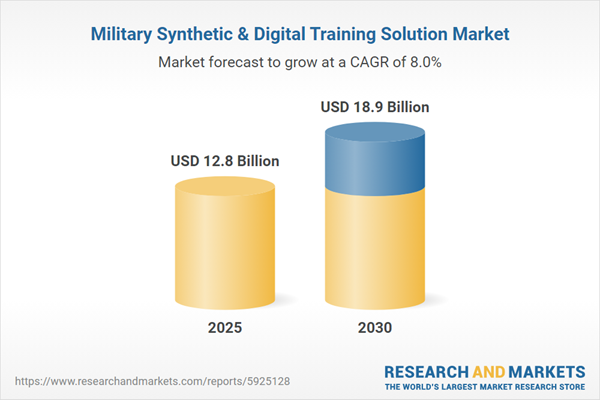Speak directly to the analyst to clarify any post sales queries you may have.
Military synthetic and digital training solutions are rapidly transforming how defense organizations build readiness and respond to evolving threats. With a shift toward scalable, immersive, and resilient digital environments, senior decision-makers gain new tools to maintain operational continuity while aligning with strategic modernization goals.
Market Snapshot: Military Synthetic & Digital Training Solution Market
The military synthetic and digital training solution market is currently valued at USD 11.89 billion, driven by a projected compound annual growth rate (CAGR) of 8.22%. Advances in immersive digital technologies are accelerating the sector’s digital transformation, with senior leaders prioritizing investments that strengthen technological parity in defense. Strategic partnerships and adoption of advanced platforms are allowing defense organizations to keep pace with global security needs and streamline procurement models. The increased integration of these solutions is shaping modernization initiatives and enabling militaries worldwide to anticipate and address emerging challenges effectively.
Scope & Segmentation of Military Synthetic & Digital Training Solutions
Comprehensive analysis of the military synthetic and digital training solution market allows defense executives to tailor modernization strategies. Core market segments reflect a wide range of operational demands, technology uses, and regional adoption patterns across the sector.
- Hardware Components: Simulators, VR headsets, and haptic devices facilitate realistic training scenarios for mission rehearsal and tactical evaluation.
- Services: Advisory support and ongoing technical services maintain the effectiveness of training systems throughout their lifecycle.
- Software Solutions: Platforms for scenario building, analytics, and connectivity provide adaptable and data-driven environments suited for evolving training needs.
- Solution Types: Live, virtual, and constructive options enable comprehensive simulation across air, ground, and maritime operations.
- Business Models: Procurement approaches, from direct acquisition to service-based agreements, help organizations manage investment and operational flexibility.
- Technology: Artificial intelligence, augmented reality, digital twins, and integration with IoT systems drive the creation of decision-ready training experiences.
- Deployment Models: Options such as on-premise and cloud-based deployments enable secure, accessible training for distributed defense teams.
- Applications: Solutions address needs in combat rehearsal, command and control, logistics, and medical readiness across diverse operational objectives.
- End Users: Tailored offerings for the Air Force, Army, Navy, and Marine Corps respond to the unique requirements of each branch.
- Regional Coverage: Adoption trends vary across the Americas, Europe, Middle East & Africa, and Asia-Pacific, informing where defense organizations find new partnership and growth opportunities.
- Key Companies: Industry benchmarks are set by CAE Inc., L3Harris Technologies, Raytheon Technologies Corporation, Lockheed Martin Corporation, and The Boeing Company.
Key Takeaways for Senior Decision-Makers
- Integrated digital platforms help adapt military training to changing mission objectives and operational demands, strengthening workforce agility.
- Blended live, virtual, and constructive environments ensure standardized readiness objectives across all military branches, supporting consistent force development.
- Artificial intelligence and analytics enhance early identification of emerging skills gaps, equipping leaders to proactively address shifting training requirements.
- Flexible deployment options support secure, accessible training globally, helping organizations maintain compliance with data protection and security directives.
- Utilizing digital twins increases situational awareness and informs infrastructure decisions, promoting optimal allocation of training resources.
- Modular architecture makes it easier to integrate new capabilities and protect earlier investments as operational requirements evolve.
Tariff Impact: Navigating Supply Chain and Procurement Shifts
Recent adjustments in U.S. tariffs have increased costs for essential training hardware, including simulators and haptic devices. To manage these shifts, defense agencies are placing greater emphasis on domestic manufacturing and forming new regional supply partnerships. Flexible procurement models such as pay-as-a-service allow organizations to expand training capacity and sustain agility, even as global supply chain challenges continue. Strategic procurement planning now emphasizes operational resilience and long-term cost management.
Methodology & Data Sources
This report is grounded in direct interviews with defense procurement leaders and operational authorities, supplemented by a thorough review of government and industry technical sources. The approach aligns findings with established acquisition standards and validated training performance metrics.
Why This Report Matters
- Offers actionable guidance for investment in digital training solutions that reflect current modernization goals and complex compliance requirements.
- Clarifies technology, adoption, and procurement trends to better equip senior decision-makers operating in dynamic and highly regulated defense environments.
- Presents regionally relevant insights to support business development, build competitive strategy, and inform high-level organizational planning.
Conclusion
Military synthetic and digital training solutions are foundational for achieving agility and readiness in defense. This analysis supports strategic leaders as they plan modernization pathways and strengthen mission capability for evolving global demands.
Additional Product Information:
- Purchase of this report includes 1 year online access with quarterly updates.
- This report can be updated on request. Please contact our Customer Experience team using the Ask a Question widget on our website.
Table of Contents
3. Executive Summary
4. Market Overview
7. Cumulative Impact of Artificial Intelligence 2025
Companies Mentioned
The companies profiled in this Military Synthetic & Digital Training Solution market report include:- CAE Inc.
- L3Harris Technologies, Inc.
- Raytheon Technologies Corporation
- Lockheed Martin Corporation
- The Boeing Company
- Thales S.A.
- BAE Systems PLC
- Leonardo S.p.A.
- Airbus S.E.
- General Dynamics Mission Systems, Inc.
- Indra Sistemas, S.A.
- Kongsberg Gruppen ASA
- Leidos, Inc.
- Leonardo S.p.A.
- Northrop Grumman Systems Corporation
- Reiser Simulation and Training GmbH
- Saab AB
- Singapore Technologies Engineering Ltd.
- DiSTI Corporation
- Cubic Corporation
- Kratos Defense & Security Solutions, Inc.
Table Information
| Report Attribute | Details |
|---|---|
| No. of Pages | 183 |
| Published | November 2025 |
| Forecast Period | 2025 - 2032 |
| Estimated Market Value ( USD | $ 12.8 Billion |
| Forecasted Market Value ( USD | $ 22.4 Billion |
| Compound Annual Growth Rate | 8.2% |
| Regions Covered | Global |
| No. of Companies Mentioned | 22 |









